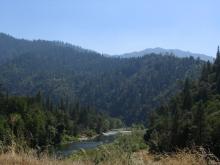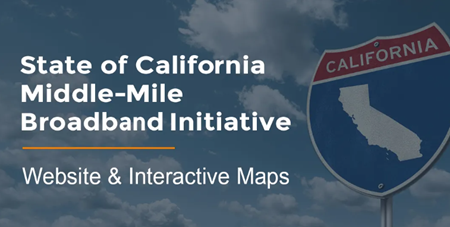
Fast, affordable Internet access for all.

A new chapter in state-Tribal relations is being written as the importance of robust and reliable telecommunication becomes all-too-apparent, especially in the face of more frequent extreme weather events. For the first time, a Tribe in California is building high-speed Internet infrastructure in collaboration with the state, thanks to the resilience of the Hoopa Valley people.
Tucked along the Trinity River in the northwestern corner of the state, the Hoopa Valley Reservation is located in a rural and heavily wooded region that spans over 89,000 acres, home to over 2,500 Tribal citizens. Last summer, the area was ravaged by closely-timed wildfires and thunderstorms, followed by massive landslides that collapsed into the region’s riverways, including the Trinity River, a sacred body of water for the Hoopa Tribe.
As the river turned to mud and dead fish began to wash up on its banks, alarmed residents had limited means of connecting with one another, getting timely information about what was going on, or contacting emergency services. That was because of a hidden casualty of the wild weather: the Tribe’s wireless Internet network, which sustained severe damage that not only hindered communication but also extended the time it took to assess the damage.
The wildfires and storms exposed the wireless network’s limitations. But fortunately, the Hoopa Valley Public Utility District (PUD) had already been working on a plan to build a more resilient and robust network for the Tribe and surrounding community. After significant planning and grant application work, and two years spent waiting to hear back from the National Telecommunications and Information Administration (NTIA) for approval, in March of 2023 the Hoopa Valley Public Utilities District (HVPUD) received a $65 million grant from NTIA under the $3 billion Tribal Broadband Connectivity Program, established when Congress passed the bipartisan infrastructure law.

With the grant now secure, Hoopa Valley is on the cusp of building out a fiber network and more reliable wireless infrastructure to provide high-speed Internet access to over 1,000 on-reservation homes currently without service. The project will also connect 64 Tribal businesses and 19 community anchor institutions.
The new infrastructure will enable Hoopa Valley officials to better respond to public emergencies, facilitate better communication channels both within and beyond the reservation, support student learning, promote economic development, and assist with cultural preservation – among the many other benefits that come with reliable broadband access. A portion of the funding is being set aside to build a new Tribal data center, a new wireless tower, and to pay for workforce development training for staff.
Landmark Collaboration with State of California
This fall, Hoopa entered into a partnership with the state of California to jointly construct 23 miles of fiber optic middle file infrastructure on the reservation. The joint build is the result of collaborative work by the California Department of Technology, the Hoopa Valley Public Utilities District (HVPUD), and the Corporation for Education Network Initiatives in California’s Golden State Network program.
The state has also contracted with Hoopa to manage network operations and maintenance, establishing the Tribe as a professional service provider and a dependable resource to help manage the state’s middle-mile infrastructure.

The collaboration is part of California’s larger effort to extend its middle-mile infrastructure, made possible by the passage of Senate Bill 156.
The legislation set aside $3.25 billion for the construction of a state-wide open-access, middle-mile network and while most of the project funds come courtesy of the federal government, the state of California chipped in $10.25 million to help move the project along.
The partnership comes at a fortuitous moment as state leaders look to mend and improve relationships with Tribes whose lands fall within its borders. It can also be considered a signal that state leaders are not content with mere lip service and a formal apology issued to Tribes for “historical wrongs tolerated, encouraged, subsidized and committed by State actors against California Native Americans.”
While the investments made by the state and NTIA are important steps forward, they are only part of the solution to getting Tribal citizens online and using the Internet to improve their quality of life. HVPUD General Manager Linnea Jackson considers the federal investment a promising start but noted how start-up costs are only one piece of the puzzle:
“Sixty-five million sounds like a lot of money, but also within the state of California, everything's more expensive — fuel, energy, all up and down the supply chain. It kind of blows my mind that the government's going to invest this money, but then also not see the parallel components that are also needed for business development, sustainability, offsets and resources that are gonna be needed to make this all sustainable.”
She also noted how government policies have historically favored larger ISPs with development offsets, making it easier for those providers to sustain themselves over the long term. Meanwhile, that kind of support has not been available to Tribes in the same way.
New Chapter in State-Tribal Relations
Though Tribes historically have not had the same opportunities as larger providers, Jackson hopes the California partnership will serve as a model for future collaboration between Tribal and state governments, describing it as a “paradigm shift” in the way that states interact with Tribal ISPs. Jackson said the collaborative project marks the beginning of a period of greater investment in Tribal providers – especially relevant as states develop plans to distribute their BEAD allocations. Supporters hope the joint middle-mile project will set a concrete precedent for Tribal/state joint investment that truly serves the needs of those living in Indian Country.

Another important part of the project involves the Hoopa Valley PUD “training members who will be [partly] responsible for the maintenance of the state’s network expansion,” providing another example of the way the state and Tribe is trying to integrate their broadband efforts to serve Tribal residents while also bringing high-quality connections to areas that fall outside of the reservation.
Jackson said she sees hope in the future of California’s relationships with Tribal providers. And with nearly 1 in 5 federally recognized Native American Tribes in the United States located in California, she sees a way for Tribes in the state to have a real seat at the table when it comes to vital decisions about broadband infrastructure investments.
Not that the process has been perfect. As Jackson points out, in order to maximize opportunities for relationship-building between the state and its Indigenous communities, consistent consultations between state officials and Tribal governments should become the norm because they are the best way for state officials to understand Tribal connectivity needs and ensure that Tribes get access to federal BEAD dollars.

To that end, Jackson said the Hoopa Valley Tribe is scheduled to meet with state broadband officials to discuss how the Tribe might receive additional funding from the BEAD program.
This new approach was succinctly captured by Tribal Business News who recently wrote that what is happening is an example of how the state is redefining the “role of the public sector beyond a regulator or safety net,” and is positioning itself as a “non-biased facilitator in the market [...] attempting to pave a path toward digital equity.”
As Hoopa Valley PUD paves a path for better connectivity for both Tribal and non-Tribal Californians, the know-how Hoopa leaders are gathering is also being shared with other Tribes across the nation.
Hoopa Valley PUD network engineers and technicians have participated in all nine of the Tribal Broadband Bootcamps (including the most recent boot camp hosted by the Cheyenne River Sioux Tribe Telephone Authority) – with Hoopa Valley’s broadband team playing an integral role in an initiative that began in 2021 as a way for Tribes with telecom experience to share knowledge with other Tribes looking to establish their own high-speed Internet networks.
To learn more about the Hoopa Valley Public Utility’s broadband project and how the Tribal Broadband provider operates, listen to the recording of our recent Tribal Broadband webinar featuring Linnea Jackson, General Manager of HVPUD.
Header image of Trinity River in Hoopa Valley courtesy of Flickr user Ken Lund, Attribution-ShareAlike 2.0 Generic
Inline image of Hoopa Valley PUD General Manager Linnea Jackson courtesy of Christopher Mitchell
Inline image of Hoopa Valley Broadband Manager Matthew "Speygee" Douglas courtesy of Christopher Mitchell
